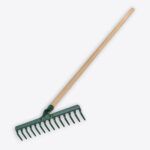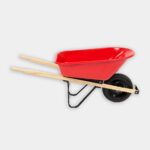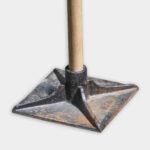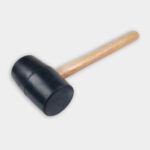We may be compensated if you purchase through links on our website. Our team is committed to delivering honest, objective, and independent reviews on home products and services.
A pea stone walkway is a charming and functional addition to your outdoor space, creating a welcoming path that connects different areas of your property. This DIY project improves your home’s curb appeal and offers a practical solution for foot traffic.
In this guide, we’ll walk you through the process of installing a pea stone walkway, drawing inspiration from a project completed by Ask This Old House mason Mark McCullough. In the video above, McCullough extends a homeowner’s existing walkway to connect with their driveway and shares his tips for a successful installation.
Planning Your Pea Stone Walkway
Before diving into the installation process, plan your walkway carefully. Think about the layout, gather your materials, and prepare the site. Good planning will help the installation go smoothly and give you a result that looks great with your home’s exterior.
Choosing the Location and Layout
When selecting the location for your pea stone walkway, think through several factors that will influence both its appearance and functionality. Natural foot traffic patterns should guide the path’s direction, creating a logical and accessible route. Account for existing landscaping features that the walkway should complement or avoid. Drainage is also key to keeping water from pooling on the path. Lastly, placing the walkway near your home’s entrance and driveway can make it more useful.
Use landscape marking paint to outline the proposed path, then make sure it integrates well with your property’s overall design. You can also use a garden hose to shape the walkway and get a feel for how it will look.
Gathering Materials and Tools
Make sure you have all the materials you’ll need to build a strong and attractive walkway:
- Base gravel: Supports the pea stone and provides drainage.
- Bluestone pavers: An optional addition for a more defined and stable path.
- Cement mix: Needed if you’re using mortar for the edging.
- Cobblestones or edging materials: Used to define the walkway’s borders.
- Landscape fabric: Prevents weed growth and aids in drainage.
- Pea gravel: The primary material for the surface of the walkway.
Tools you’ll need for the job include:
- Hand tamper
- Mason’s string
- Plate compactor
- Rakes
- Rubber mallet
- Shovels
- Stakes
- Wheelbarrow
Preparing the Site
Here’s how to prep the area:
- Excavation: Remove any existing grass and topsoil to a depth of 4–6 inches to create a stable foundation.
- Leveling and drainage: Make sure the area is level and sloped so that water drains properly.
- Utility location: Call your local utility locating service to mark any underground lines before you dig.
Installing the Pea Stone Walkway
With your site prepped and materials gathered, you’re ready to begin the installation process. Follow these steps to get a durable, long-lasting path.
Step 1: Lay Out the Walkway and Remove Topsoil
Start by using landscape marking paint to draw the rough layout and shape of your walkway on the grass. Once you’re happy with the design, remove the topsoil between the painted lines using a shovel or pick axe. Haul away the excess dirt with a wheelbarrow.
Pro tip: Adding some curves or gentle slopes can make the walkway more interesting and help it blend into the landscape.
Step 2: Compact the Soil and Install Mason’s Strings
Use a plate compactor to pack down the soil firmly. You may need to go over the area a few times to get a solid base. Once the soil is compacted and smooth, drive stakes into each corner of the walkway area. Stretch mason string along the length of the walkway on both sides, checking that it’s taut and level at all corners.
Step 3: Install Edging or Cobblestones
If you’re using cobblestones for edging, mix cement and water in a wheelbarrow until it reaches an oatmeal-like consistency. Lay a thick bed of cement under each cobblestone, tapping them down with a rubber mallet until they’re level with the mason’s string. This helps define the walkway and keeps the pea stone in place.
Step 4: Lay Landscape Fabric
Cover the walkway area between the edging with landscape fabric, overlapping the seams by 6–12 inches to prevent any gaps as the fabric settles. Secure the fabric in place with a few handfuls of base stone. This layer prevents weed growth and helps improve drainage.
Step 5: Add and Compact Base Gravel
Pour base gravel over the landscape fabric, evenly spreading it with a rake to a depth of about two inches. Use the plate compactor to pack down the gravel firmly. Lightly spray the gravel with water while compacting it to help it settle. This base layer will give the walkway support and stability.
Step 6: Install Pavers (Optional)
If you’re adding pavers, carefully place them on top of the base gravel. Adjust their positions as needed, then use a rubber mallet to tap them down. You can add or remove the base stone underneath each paver to eliminate any rocking or wobbling.
Step 7: Fill With Pea Stone
With the edging and any pavers in place, fill the walkway with pea stone. Slightly overfill the area, then use a hand tamp to pack the stones down tightly and lock everything in place.
Complementary Landscape Features for a Pea Stone Walkway
To enhance the look and function of your pea stone walkway, you can add complementary features. For example, incorporating lighting along the edges can make the walkway safer, especially in the evening. Planting flowers or shrubs along the path adds color and texture, while garden sculptures or planters can add a personal touch.
Maintaining Your Pea Stone Walkway
Regular upkeep will keep your walkway looking great and working well for years. Here’s how to maintain it:
- Cleaning: Clean the walkway occasionally with a leaf blower or garden hose to remove debris.
- Depth maintenance: Add additional pea stone as needed to maintain the desired depth, preventing bare spots.
- Stone distribution: Rake the stones periodically to keep them evenly distributed.
- Weed control: Pull out any weeds that grow through the fabric to keep the walkway tidy.






